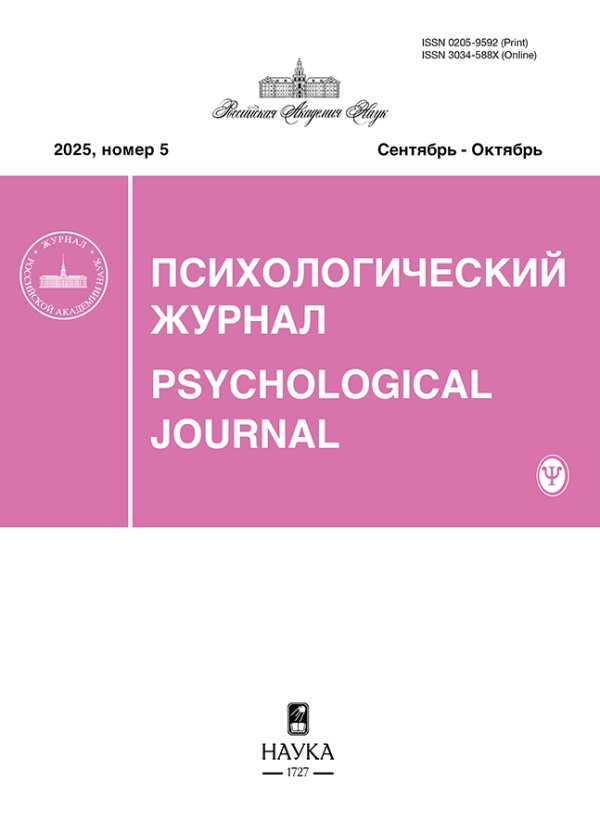Результаты адаптации короткой версии методики выраженности киберхондрии на российской выборке
- Авторы: Дейнека О.С.1, Максименко А.А.1, Забелина Е.В.2, Гаркуша С.А.1
-
Учреждения:
- Санкт-Петербургский государственный университет
- Челябинский государственный университет
- Выпуск: Том 44, № 1 (2023)
- Страницы: 101-112
- Раздел: Методы и методики
- URL: https://modernonco.orscience.ru/0205-9592/article/view/661056
- DOI: https://doi.org/10.31857/S020595920024365-7
- ID: 661056
Цитировать
Полный текст
Аннотация
В последние годы наша страна и весь мир столкнулись с ситуацией масштабной эпидемии, вызванной вирусом COVID-19, которая создала благоприятные условия для развития киберхондрии. Целью исследования является теоретическое обоснование внимания исследователей к феномену киберхондрии и адаптация методики изучения выраженности киберхондрии (CSS) на российской выборке. Результаты эксплораторного факторного анализа данных исследования показали полное соответствие структуре оригинального опросника: были выделены 5 шкал, состоятельность которых была подтверждена конфирматорным факторным анализом. Все шкалы показали приемлемый уровень надежности по внутренней согласованности. В ходе проверки конвергентной валидности, были обнаружены объяснимые взаимосвязи шкал опросника и показателей толерантности к неопределенности, психологического благополучия и аддикции к социальным сетям.
Полный текст
Об авторах
О. С. Дейнека
Санкт-Петербургский государственный университет
Email: psy.journ@yandex.ru
профессор кафедры политической психологии
Россия, Санкт-ПетербургАлександр Александрович Максименко
Санкт-Петербургский государственный университет
Email: psy.journ@yandex.ru
главный научный сотрудник
Россия, Санкт-ПетербургЕ. В. Забелина
Челябинский государственный университет
Email: psy.journ@yandex.ru
доцент Института образования и практической психологии
Россия, ЧелябинскС. А. Гаркуша
Санкт-Петербургский государственный университет
Автор, ответственный за переписку.
Email: psy.journ@yandex.ru
Младший научный сотрудник
Россия, Санкт-ПетербургСписок литературы
- Влияние пандемии на личность и общество: психологические механизмы и последствия / Отв. ред. Т.А. Нестик, А.Л. Журавлев, А.Е. Воробьева. М.: изд-во “Институт психологии РАН”, 2021. 572 с.
- Дейнека О.С., Николаев А.Е. Экономико-психологический анализ проблемных зон отечественного здравоохранения // Экономическая психология: современные проблемы и перспективы развития. Материалы 15-й Межд. научн.-практ. конф. (СПб, 24–27 ноября 2015 г.). СПб: НВШ-СПб, 2015. С. 55–66.
- Духанина Л.Н., Максименко А.А. Анализ сетевого онко-дискурса трехлетней ретроспективы в домене верхнего уровня RU // Вопросы онкологии. 2020. №4. Т. 66. С. 315–324.
- Ениколопов С.Н., и др. Динамика психологических реакций на начальном этапе пандемии COVID-19 // Психолого-педагогические исследования. 2020. Т. 12. № 2. C. 108–126.
- Журавлев А.Л., Китова Д.А. Анализ интереса населения к информации о пандемии коронавируса (на примере пользователей поисковых систем интернет) // Психологический журнал. 2021. Т. 41. №4. С. 5–18.
- Малышева Г.А. Социально-политические аспекты пандемии в обществе цифровой сетевизации: российский опыт // Вестник Московского государственного областного университета (электронный журнал). 2020. № 3. URL: www. evestnik-mgou.ru. (Дата обращения 04.25.2022).
- Психодиагностика толерантности личности / Под ред. Г.У. Солдатовой, Л.А. Шайгеровой. М.: Смысл, 2008. 172 с.
- Шевеленкова Т.Д., Фесенко Т.П. Психологическое благополучие личности // Психологическая диагностика. 2005. № 3. С. 95–121.
- Asmundson G.J.G., Carleton R.N., Bovell C.V., Taylor S. Comparison of unitary and multidimensional models of the Whiteley Index in a nonclinical sample: Implications for understanding and assessing health anxiety // Journal of Cognitive Psychotherapy. 2008. V. 22. № 2. P. 87–96.
- Barke A., Bleichhardt G., Rief W., Doering B.K. The cyberchondria severity scale (CSS): German validation and development of a short form // International Journal of Behavioral Medicine. 2016. V. 23. № 5. P. 595–605.
- Bessière K., Pressman S., Kiesler S., Kraut R. Effects of internet use on health and depression: a longitudinal study // Journal of Medical Internet Research. 2010 V. 12. № 1. e6.
- Boysan M., Eşkisu M., Çam Z. Relationships between fear of COVID-19, cyberchondria, intolerance of uncertainty, and obsessional probabilistic inferences: A structural equation model // Scand J Psychol. 2022. V. 63. № 5. P. 439–448.
- Doherty-Torstrick E.R., Walton K.E., Fallon B.A. Cyberchondria: Parsing health anxiety from online behavior // Psychosomatics. 2016 V. 57. № 4. P. 390–400.
- Fergus T.A. The Cyberchondria Severity Scale (CSS): an examination of structure and relations with health anxiety in a community sample // Journal of Anxiety Disorders. 2014. V. 28. № 6. P. 504–510.
- Fergus T.A. Anxiety sensitivity and intolerance of uncertainty as potential risk factors for cyberchondria: a replication and extension examining dimensions of each construct // Journal of Affective Disorders. 2015. V. 184. P. 305–309.
- Fergus T.A., Russell L. Does cyberchondria overlap with health anxiety and obsessive-compulsive symptoms? An examination of latent structure and scale interrelations // Journal of Anxiety Disorders. 2016. V. 38. P. 88–94.
- Infanti A., et al. Predictors of cyberchondria during the COVID-19 pandemic: A supervised machine learning approach // Journal of Behavioral Addictions. 2022. V.11. № 1. P. 73–73.
- Mathes B.M., et al. Cyberchondria: Overlap with health anxiety and unique relations with impairment, quality of life, and service utilization // Psychiatry Research. 2018. V. 261. P. 204–211.
- McElroy E., et al. The CSS-12: Development and validation of a short-form version of the cyberchondria severity scale // Cyberpsychology, Behaviour and Social Networking. 2019. V. 22. № 5. P. 330–335.
- McElroy E., Shevlin M. The development and initial validation of the cyberchondria severity scale (CSS) // Journal of Anxiety Disorders. 2014. V. 28. P. 259–265.
- McMullan R.D., Berle D., Arnáez S., Starcevic V. The relationships between health anxiety, online health information seeking, and cyberchondria: Systematic review and meta-analysis // Journal of Affective Disorders. 2019. V. 245. P. 270–278.
- Muse K., et al. Cyber-chondriasis: fact or fiction? A preliminary examination of the relationship between health anxiety and searching for health information on the internet // Journal of Anxiety Disorders. 2012. Vol. 26. P. 189–196.
- Norr A., et al. Anxiety sensitivity and intolerance of uncertainty as potential risk factors for cyberchondria // Journal of Affective Disorders. 2015. V. 174. P. 64–69.
- Norr A., Capron D., Schmidt N.B. Medical information seeking: impact on risk for anxiety psychopathology // Journal of Behavior Therapy and Experimental Psychiatry. 2014. V. 45. № 3. P. 402–407.
- Selvi1 Y., et al. The Cyberchondria Severity Scale (CSS): Validity and Reliability Study of the Turkish Version. Sleep and Hypnosis // A Journal of Clinical Neuroscience and Psychopathology. 2018. V. 20. № 4. P. 241–246.
- Peng X-Q., et al. The Status and Influencing Factors of Cyberchondria During the COVID-19 Epidemic. A Cross-Sectional Study in Nanyang City of China // Front. Psychol. 2021. № 11.
- Starcevic Vl., Berle D. Cyberchondria: Towards a better understanding of excessive health-related Internet use // Expert Review of Neurotherapeutics. 2013. V. 13. № 2. P. 205–213.
- te Poel F., Baumgartner S.E., Hartmann T., Tanis M. The curious case of cyberchondria: A longitudinal study on the reciprocal relationship between health anxiety and online health information seeking // Journal of Anxiety Disorders. 2016. V. 43. P. 32–40.
- Tutgun-Ünal A., Deniz L. Development of the Social Media Addiction Scale // AJIT‐e Online Academic Journal of Information Technology.: 2015. V. 6. №. 21. P. 51–70.
- Vismara M., et al. New challenges in facing New challenges in facing Cyberchondria during the coronavirus disease pandemic // Curr Opin Behav Sci. 2022. V. 46. P. 101156.
- Vismara M., et al. The Impact of COVID-19 Pandemic on Searching for Health-Related Information and Cyberchondria on the General Population in Italy // Front psychiatry. 2021. № 12.
- Wang X., Lee K.M. The paradox of technology innovativeness and risk perceptions – A profile of Asian smartphone users // Telematics and Informatics. 2020. V. 51. P. e101415.
- White R.W., Horvitz E. Cyberchondria: Studies of the escalation of medical concerns in web search // ACM Trans. Inf. Syst. 2009. V. 27. № 4. P. 1–37.
- Zheng H., Kim H. K., Sin S.-Ch. J., Theng Y.-L. A theoretical model of cyberchondria development: Antecedents and intermediate processes // Telematics and Informatics. 2021. V. 63. P. 101659.
- Zheng H., Tandoc E.C. Calling Dr. Internet: Analyzing news coverage of cyberchondria // Journalism Practice. 2020. V. 16. № 5. P. 1001–1017.
Дополнительные файлы









